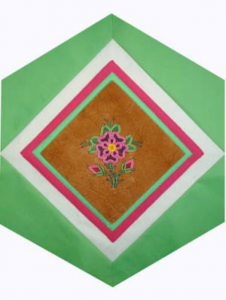Beaver

The Block
Beaver block-maker, Ida Kazonay Kushneryk, has created a vibrant Arctic Rose with buds, beaded on a thick, tanned moose-hide background. The moose is significant to the Beaver people, having provided them with sustenance for centuries, and the Arctic Rose is a common pattern used in Beaver artistic expression. The inspiration for the image is drawn from nature. Using techniques learned from her mother, Ida beaded the large Arctic Rose, with its delicate buds, in bright pink and lime rocaille (or rochelli) beads, which give the flower texture and depth.
Cultural Profile
The Beaver Nation, also known as Dunne-za (“the real people”) or the Tsattine (“dwellers among the beavers”), belongs to the Athapascan language group. They originally inhabited the area along what is now the Alberta-Saskatchewan border. Here they lived in small family groups for most of the year, but came together each summer to live with relatives, to sing and to dance.
Beavers had a strong belief in the supernatural and travelled with medicine men and women, with healers, and with prophets. One prophet, named Makenunatane (Swan Chief), predicted the coming of white men to the Peace River valley area at the end of the 18th century. In 1650, the original Beaver Nation, who are also related to the Slavey and Chipewyan, separated into three groups: Beaver, Strongbow (now extinct), and Sarcee (Tsuu Tina). Many Beaver Indian bands today have mixed Cree or Sekani heritages.
Known as exceptional hunters, the Beaver used moose as a dietary staple. Today the two northern Alberta reservations continue a 200-year tradition chiefly as farming communities. In the 20th century, lumber, coal, petroleum, and natural gas have added to the economy. At the time of contact, four Beaver bands numbered 1,000 people; in September 2003, census records counted 725 registered Beavers.
Sponsor: Adaire Chown Schlatter
